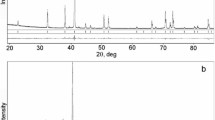Conclusions
-
1.
The catalytic effect of metal oxides on the process of boronizing has to do with the semiconductor properties of these oxides. The electron-hole conduction of metal oxides improves the electron interchange between reagents, accelerating oxidation of boton carbide and the boronizing process.
-
2.
Acceleration of saturation with boron based on the oxygen activation ions with lower valency is caused predominantly by oxides that are p-type semiconductors in which the disordered structure and the proportion of electron-hole conduction are determined by the partial pressure of oxygen in the system.
-
3.
The application of the tenets of the electron theory of heterogeneous catalysis of chemical processes to semiconductors together with thermodynamic analysis of redox reactions is an effective direction of searching for optimal activators for currentless boronizing and possibly also for other methods of TCT.
Similar content being viewed by others
Literature cited
L. G. Voroshnin and L. S. Lyakhovich, Boronizing of Steel [in Russian], Metallurgiya, Moscow (1978).
G. V. Samsonov and A. P. Épik, High-Melting Coatings [in Russian], Metallurgiya, Moscow (1973).
N. G. Ilyushchenko et al., ”Diffusion coating of metals in melted salts,” in: Heat-Resisting and Heatproof Coatings: Transactions of the 4th All-Union Conference on Heat-Resistant Coatings (Leningrad, May, 1963) [in Russian], Nauka, Leningrad (1969), pp. 105–120.
B. N. Polyakov, ”Special features of the mechanism of oxygen activation of boronizing with rapid heating with high-frequency current,” Metalloved. Term. Obrab. Met., No. 5, 47–51 (1982).
L. P. Vladimirov, Thermodynamic Calculations of the Equilibrium of Metallurgical Reactions [in Russian], Metallurgiya, Moscow (1970).
F. F. Vol'kenshtein, The Electron Theory of Catalysis on Semiconductors [in Russian], Fizmatigiz, Moscow (1960).
B. N. Polyakov, ”The mechanism of oxygen activation of the boronizing process with a liquid phase,” Metalloved. Term. Obrab. Met., No. 12, 10–13 (1988).
O. A. Esin, Electrode processes in molten slags, in: The Physical Chemistry of Molten Slags [in Russian], Naukova Dumka, Kiev (1970), pp. 5–34.
P. Kofstad, High-Temperature Oxidation of Metals [Russian translation edited by O. P. Kolchin], Mir, Moscow (1969).
L. S. Lyakhovich, É. M. Puchkov, É. D. Shcherbakov, and L. G. Voroshnin, ”Electrolytical boronizing in industrial baths and their refining,” in: Progressive Methods of Heat Treatment and Thermochemical Treatment, Mashinostroenie, Moscow (1972), pp. 145–151.
A. A. Zhukovitskii and L. A. Shvartsman, Physical Chemistry [in Russian], Metallurgizdat, Moscow (1968).
A. G. Vinitskii, L. S. Malinov, V. V. Moshnyagul, and V. I. Kovtun, ”Investigation of the effect of an active additive on the depth and structure of the case-hardened case,” in: Protective Coatings of Metals, Issue 4, Naukova Dumka, Kiev (1971), pp. 83–88.
V. F. Loskutov, E. M. Grinenko,O. V. Semenchenko, and V. G. Permyakov, ”Strengthening the surface of parts with alloyed iron borides,” Tekhnol. Organ. Proizvod., No. 3, 41–42 (1988).
Inventors' Certificate 442238 USSR, MKI C23C9/04. Composition for the Boronizing of Steel.
Additional information
Scientific and Production Association ”RostNIITM.” Translated from Metallovedenie i Termicheskaya Obrabotka Metallov, No. 9, pp. 36–39, September, 1991.
Rights and permissions
About this article
Cite this article
Polyakov, B.N. Role of semiconductor phenomena in boronizing. Met Sci Heat Treat 33, 708–712 (1991). https://doi.org/10.1007/BF00811738
Issue Date:
DOI: https://doi.org/10.1007/BF00811738




